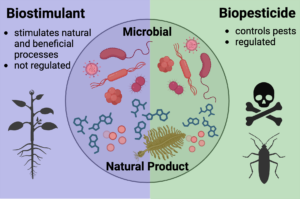Agricultural Biologicals
go.ncsu.edu/readext?985295
en Español / em Português
El inglés es el idioma de control de esta página. En la medida en que haya algún conflicto entre la traducción al inglés y la traducción, el inglés prevalece.
Al hacer clic en el enlace de traducción se activa un servicio de traducción gratuito para convertir la página al español. Al igual que con cualquier traducción por Internet, la conversión no es sensible al contexto y puede que no traduzca el texto en su significado original. NC State Extension no garantiza la exactitud del texto traducido. Por favor, tenga en cuenta que algunas aplicaciones y/o servicios pueden no funcionar como se espera cuando se traducen.
Português
Inglês é o idioma de controle desta página. Na medida que haja algum conflito entre o texto original em Inglês e a tradução, o Inglês prevalece.
Ao clicar no link de tradução, um serviço gratuito de tradução será ativado para converter a página para o Português. Como em qualquer tradução pela internet, a conversão não é sensivel ao contexto e pode não ocorrer a tradução para o significado orginal. O serviço de Extensão da Carolina do Norte (NC State Extension) não garante a exatidão do texto traduzido. Por favor, observe que algumas funções ou serviços podem não funcionar como esperado após a tradução.
English
English is the controlling language of this page. To the extent there is any conflict between the English text and the translation, English controls.
Clicking on the translation link activates a free translation service to convert the page to Spanish. As with any Internet translation, the conversion is not context-sensitive and may not translate the text to its original meaning. NC State Extension does not guarantee the accuracy of the translated text. Please note that some applications and/or services may not function as expected when translated.
Collapse ▲Overview
Agricultural biologicals are a rapidly growing class of agronomic inputs derived from microbes, plants, or other living organisms. The global market value of biologicals is predicted to exceed 33 billion USD by 2030 (Fortune Business Insights 2023). These biological technologies harness nature-based solutions for crop production and protection and are classified into two major categories: biostimulants and biopesticides.
Biostimulants are defined by the USDA in the 2018 Farm Bill and the Plant Biostimulants Act of 2023 as “a substance or micro-organism that, when applied to seeds, plants, or the rhizosphere, stimulates natural processes to enhance or benefit nutrient uptake, nutrient efficiency, tolerance to abiotic stress, or crop quality and yield.” In the United States, biostimulants are not federally regulated but are typically registered at the state-level (similar to fertilizers). Biostimulants can be further classified by their source material as microbial or natural products.
- Microbial biostimulants are living microbes (e.g., bacteria and fungi) that can carry out a range of plant growth promoting activities such as improved plant water and nutrient use efficiency, enhanced germination and plant development, and increased stress tolerance. The term “biofertilizer” is sometimes used interchangeably with microbial biostimulant and refers to microbial products that improve plant nutrient acquisition.
- Natural product biostimulants are natural substances produced or extracted from microbes, plants, or other organisms. Natural products encompass diverse materials ranging from seaweed extracts, organic acids (i.e, humic and fulvic acids), vitamins, and biopolymers (i.e., chitin or chitosan).
Biopesticides are substances derived from living organisms intended for preventing, destroying, repelling, or mitigating any pest. Biopesticides include naturally occurring substances that control pests (biochemical pesticides), microorganisms that control pests (microbial pesticides), and pesticidal substances produced by plants from added genetic material (plant-incorporated protectants or PIPs). Biopesticides are federally regulated by the EPA (find a list of registered biopesticide active ingredients here).
Fertilizers are any materials that supply plant-bioavailable macronutrients and/or micronutrients. Fertilizers can be organic or inorganic (derived from living organisms or non-living substances) and natural or synthetic. An important distinction between fertilizers and biostimulants is plants directly uptake nutrients from fertilizers, while biostimulants stimulate beneficial biological processes – which can include increased nutrient acquisition.

Agricultural biologicals can be biostimulants (that stimulate beneficial processes) or biopesticides (that control pests), and these substances can be living microbes or natural products. Image created in BioRender.
Summary
Agricultural biologicals are a promising class of inputs engineered for reducing dependence on synthetic chemicals and for supporting crop health and productivity. Biologicals can be biostimulants that stimulate a range of beneficial processes, or biopesticides that controls pests. Biologicals can be living microbes, or natural products derived from living organisms. Biopesticides are federally regulated, but biostimulants are not.


